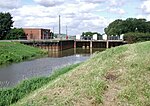Preston Road Estate
Geographic coordinate listsGeographic histories of Kingston upon HullHousing estates in Kingston upon HullLists of coordinatesUse British English from November 2019 ... and 1 more
Wards and districts of Kingston upon Hull

Preston Road Estate, also known as the East Hull Estate, is a housing estate in the east of Kingston upon Hull built from the 1920s to the 1940s by Hull Corporation. At the beginning of the 21st century considerable redevelopment of the estate took place, with a large community centre established, and demolition or modification of older substandard houses. The Eastern Cemetery established 1931 at the east of the estate is contemporary with the original build. The estate contains few structures of note, excluding the large Archbishop Sentamu Academy.
Excerpt from the Wikipedia article Preston Road Estate (License: CC BY-SA 3.0, Authors, Images).Preston Road Estate
Preston Road, Hull Marfleet
Geographical coordinates (GPS) Address Nearby Places Show on map
Geographical coordinates (GPS)
| Latitude | Longitude |
|---|---|
| N 53.758043 ° | E -0.282483 ° |
Address
Preston Road
Preston Road
HU9 3QB Hull, Marfleet
England, United Kingdom
Open on Google Maps









